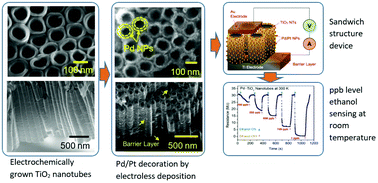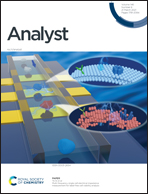Electroless deposition of Pd/Pt nanoparticles on electrochemically grown TiO2 nanotubes for ppb level sensing of ethanol at room temperature
Abstract
This work presents a comparative sensing study of three sensors based on pristine TiO2 nanotubes, Pd loaded TiO2 nanotubes, and Pt loaded TiO2 nanotubes. Pristine TiO2 nanotubes were synthesized using an electrochemical anodization method and an electroless plating method was used for the uniform deposition of noble metal nanoparticles of either Pd or Pt over the surface of TiO2 nanotubes. The samples were thoroughly characterized by XRD, FESEM, EDS, TEM, and XPS techniques. The sensitivity of all three sensors was investigated at room temperature (300 K) for different volatile organic compounds like ethanol, methanol, 2-propanol, acetone, and benzene. The results revealed that loading of Pd and Pt nanoparticles improved the response magnitude of the sensor remarkably as these noble metals possess better oxygen dissociation capability than pristine TiO2. The Pd–TiO2 nanotube sensor exhibited a maximum response magnitude of 20–98% towards 100–1000 ppb of ethanol at room temperature. Notably, the formation of Pd/Pt–TiO2 discrete heterojunctions on the surface of TiO2 nanotubes was found to be responsible for enhanced sensitivity of the sensors.



 Please wait while we load your content...
Please wait while we load your content...